
Salix caprea, known as goat willow, pussy willow or great sallow, is a common species of willow native to Europe and western and central Asia.

Salix fragilis, with the common names crack willow and brittle willow, is a species of willow native to Europe and Western Asia. It is native to riparian habitats, usually found growing beside rivers and streams, and in marshes and water meadow channels.

Lycopodium clavatum is the most widespread species in the genus Lycopodium in the clubmoss family.

Salix cinerea is a species of willow native to Europe and western Asia.
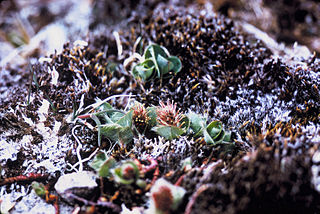
Salix arctica, the Arctic willow, is a tiny creeping willow. It is adapted to survive in Arctic conditions, specifically tundras.

Salix nigra, the black willow, is a species of willow native to eastern North America, from New Brunswick and southern Ontario west to Minnesota, and south to northern Florida and Texas.

Salix lasiolepis is a species of willow native to western North America.
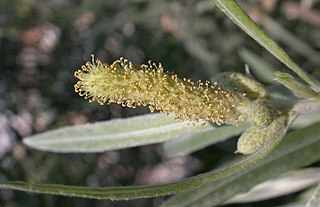
Salix exigua is a species of willow native to most of North America except for the southeast and far north, occurring from Alaska east to New Brunswick, and south to northern Mexico. It is considered a threatened species in Massachusetts while in Connecticut, Maryland, and New Hampshire it is considered endangered.

Artemisia nova is a North American species of sagebrush, known by the common name black sagebrush. It is "one of the most common shrubs in the western United States".
Salix barrattiana is a species of flowering plant in the willow family known by the common name Barratt's willow. It is native to North America, where it is distributed across Alaska and western Canada, with also a few populations in Montana and Wyoming. These disjunct populations are probably relics from a time when the climate was colder. The southernmost population is technically in Wyoming, but it is located at the Montana state line and it is limited to one clone of all-staminate plants within an area of 100 m2 in a high-elevation habitat.

Salix boothii is a species of willow known by the common name Booth's willow.

Salix geyeriana is a species of willow known by the common names Geyer's willow, Geyer willow and silver willow. The type specimen was collected by the botanist Karl Andreas Geyer, for whom it was named. Its conspicuous, yellow flowers begin to bloom as early as March, to as late as the end of June.

Salix gooddingii is a species of willow known by the common name Goodding's willow, or Goodding's black willow. It was named for its collector, Leslie Newton Goodding.
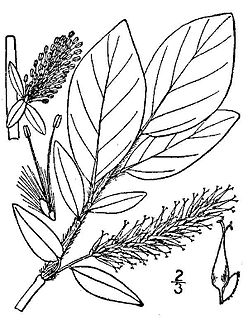
Salix barclayi, or Barclay's willow, is a species of willow native to North America, found primarily in the Northwestern area of the United States and Canada. It grows near lakes and streams at elevation. It is a shrub, that can grow up to 2.5 m. (8 ft.) tall and tends to be slender. Leaves are elliptic to obovate, 2–6 cm long and 1–2.5 cm wide. Leaves are hairy when young, with midrib hairs lasting into maturity. Catkins are on short, leafy peduncles. Staminate catkins are 3 cm long with 2 stamens, while pistillate catkins are 2.5–5 cm long and glabrous.
Salix commutata, the undergreen willow, is a plant species native to western Canada and the northwestern United States. It has been reported from Alaska, Yukon, the Northwest Territories, British Columbia, Alberta, Saskatchewan, Montana, Idaho. Washington and Oregon. It grows on rocky alpine and subalpine slopes, conifer forests, stream banks, bogs, etc.

Salix humboldtiana, called Humboldt's willow, is a tree species of willow native to North and South America, growing along watercourses. Some authorities consider it a synonym of Salix chilensis, which Molina described in 1782. Willdenow described Salix humboldtiana in 1805.
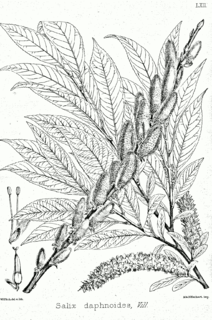
Salix daphnoides or European violet willow is a species of plant in the family Salicaceae. It can grow as a large shrub or small tree, normally reaching a height of between 6 and 8 metres, but can grow up to 12 metres tall.

Salix pedicellata is a species of willow. It is a shrub or small tree to about 6–8 m tall, native around the Mediterranean Sea from Portugal to Lebanon and Syria in the north and from the Canary Islands to Tunisia in the south. Salix canariensis may be treated as a subspecies of S. pedicellata.
Salix calcicola, known as limestone willow or woolly willow, is a species of willow native to the subarctic and Arctic regions of Canada, including Nunavut Islands, continental Nunavut, northern Quebec, Labrador. Arctic islands: Baffin, King William, Southampton, and Coats.
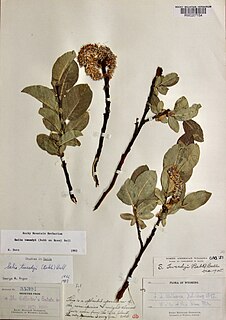
Salix tweedyi, or Tweedy's willow, is a shrub in the willow family. It is native to the northwestern United States.

















